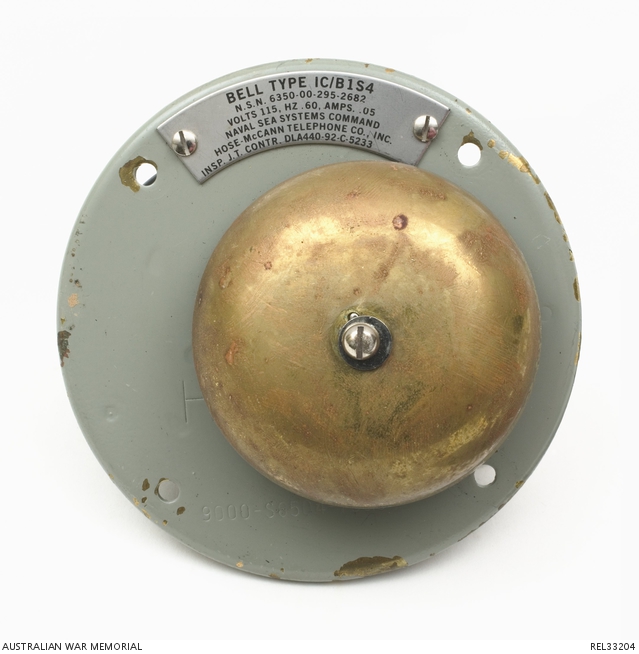| Accession Number | REL33204 |
|---|---|
| Collection type | Technology |
| Object type | Maritime vessel or watercraft |
| Maker |
Hose-McCann Telephone Co. Inc. |
| Place made | United States of America: Florida |
| Date made | Unknown |
| Conflict |
Gulf War, 1990-1991 Vietnam, 1962-1975 |
HMAS Brisbane : Bell Type IC/B1S4 and cover assembly


The unit consists of a circular cover, secured by four screws (missing). The casing of the bell is missing. On the cover is a striker and a post mount for the bell, the bell is brass and attached with one screw. There is also a metal nomenclature plaque that reads: `Bell Type IC/B1S4 N.S.N 6350-00-295-2682 Volts 115, HZ. 60, AMPS. .05 Naval Sea Systems Command, Hose McCann Telephone Co., Inc INSP, JT CONTR, DLA400-90-C-0452. Engraved on the bracket is 9000-S6504-73904. The bell has been placed slightly off centre on the cover. On the back of the cover is the mechanical backing of the bell instrument. There are four holes on the bracket to attach it to the wall etc.
This component was removed from HMAS Brisbane after the ship was de-commissioned in 2001. The Bell was fitted in an unknown location. It is part of the ship's internal communication system. HMAS Brisbane [II] was commissioned into the Royal Australian Navy in December 1967 and was the second vessel of that name to serve in the RAN. Known officially as DDG-41, Brisbane was the third of the RAN's American-built "Charles F. Adams" class guided-missiles destroyers. This class were the first major Australian warships designed and built in America, and were constructed by the Defoe Shipbuilding Co. The original complement of the Brisbane was 20 officers and over 300 sailors. Main armament was two 5-inch/54 calibre guns and anti-submarine torpedoes. The Ikara missile system was subsequently added. In later service the ship was known by the nick-name ‘the Steel Cat’. The HMAS Brisbane saw operational service in two conflicts. During the Vietnam War the ship undertook two tours of duty with the United States Seventh Fleet, in 1969 and again in 1971. The ship’s major task was to provide gunfire support for the land campaign. During the Gulf War (1990-91), Brisbane was one of four Australian warships to serve a tour in Gulf waters. The Brisbane arrived in the Gulf in December 1990 and operated there until March 1991, performing a number of roles. Apart from contributing to the anti-aircraft defences in the carrier screen, the ship also kept watch for mines and ensured that small civilian craft kept well away from the carrier group. Later, during Operation Desert Storm, the Brisbane controlled fighter combat air patrols and tanker aircraft. The ship’s final role was as an escort for US replenishment ships. In 2003 HMAS Brisbane was retired from service in the Royal Australian Navy. The Brisbane was the last steam powered ship in the RAN. HMAS Brisbane was sunk as a recreational dive wreck off the coast of southern Queensland in July 2005.